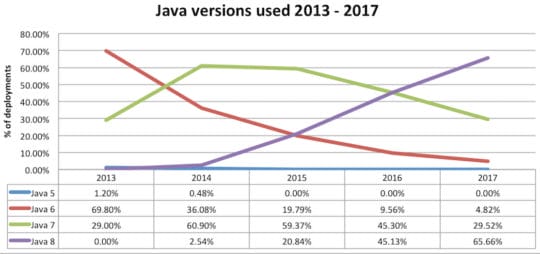The Java language is a leading programming tool for object-oriented programming, which is widely used to develop websites, mobile apps, and embedded software for microdevices and chips. Java is considered a programming language that is easier to learn compared to languages from the C# family, PHP, and Python, and the one that will power the evolution of the Internet of Things networks.
Nonetheless, Java development requires from developers to be well aware of a few core programming concepts and ideas, especially bearing in mind that at least three Java versions are in broad use today – from Java 6 to Java 8.
Object-oriented Programming Concepts in Java

Actually, one of the main advantages of Java development is the language’s object-oriented programming (OOP) capabilities. Therefore, it’s important to get to know the core OOP concepts before starting to build an app in Java. The four main OOP Java development concepts are:
- Abstraction
- Encapsulation
- Inheritance, and
- Polymorphism
Chart: Top Programming Languages

Image Source: IEEE
Abstraction in Java is the idea of representing a complex programming code through simple things such as objects, classes, and variables. This way, you create simple as well as more complex objects through which you eliminate repetitive work. Most programs contain repetitive tasks and equations all over the programming code, and abstraction is the tool to create complexity via simplicity.
Encapsulation provides you with a method to keep fields within a class private, enabling data protection across the application in the works. Access to fields is ensured through public methods but only after the fields are encapsulated. Encapsulation allows for re-using code components and variables without compromising the code security.
Inheriting attributes of existing classes is the main idea behind the inheritance concept. You create new classes and they simply get some attributes from the ones created previously, thus enabling developers to speed up work on Java websites and applications. Inheritance is also useful when you need to extend your current code to cover different use case scenarios.
Polymorphism is actually a very simple programming concept despite its weird name. It is a method for Java developers to make use of the same word in different contexts by applying a different meaning to it. The two basic methods to take advantage of polymorphism are method overloading and method overriding. In the first case, the very code implies different meanings to the word and do so in context. The method overriding concept allows variables to imply different word meanings through the variable values.
All of the above methods work best when the DRY concept is applied. The DRY (Don’t Repeat Yourself) method maintains that you should never have the same two blocks within your programming code. By creating a method, you replace identical blocks with one method, to be used for different purposes across the code.
Recommended for you: How to Learn Programming Faster – 5 Tips To Guide You.
Beyond Classes and Objects

According to Mr. John Barnett, project coordinator at Iflexion, a web development company,
“Once you get familiar with the concept of Java classes consisting of objects, you should move on to get acquainted with each of the above concepts. Furthermore, you cannot create viable Java websites and apps if you are unable to master more advanced Java concepts such as packages, exception handling, and abstract classes.”
What are packages? Simply put, packages are groups of similar classes that you keep together. They are created through a single command in Java and provide an additional layer of security. You can import packages into your program, but you can also restrict access to classes from other packages. This is a handy concept that provides a secure method to handle both classes and packages.
Since all classes in Java are made of objects, you may end up with tens and hundreds of objects within a sophisticated Java application. Each of these objects is taking space in a dedicated memory space that is called “heap” in Java. You cannot extend a heap endlessly, and you need to free space to create new objects in the fixed-size heap. Garbage collection is the process of removing old and unused objects from the heap to free space for your new objects. If the Java Virtual Machine decides that an object has no chance of being used in a further operation anymore, it will mark it as suitable for garbage collection. The Garbage Collector removes all flagged objects after you run low on memory, thus creating space for new objects.
Abstract classes are a more advanced concept that you use when you have methods without a body. You cannot create an object that belongs to an abstract class, and you will always end up with an abstract class if you have an abstract method in a class. An example of a pure abstract class is an interface. You have only abstract methods within an interface and you cannot instantiate an interface. Once you implement a non-abstract sub-class of an interface, you need to override all the abstract methods. The same applies to abstract classes in which you introduce a non-abstract sub-class.
You may also like: How to Develop Simple JavaFX Desktop Applications.
Concurrent Programming in Java 8 and Java 9 Modules
Exception handling and threads are other advanced concepts in Java development. The exception method enables Java developers to run a risky code and handle the exception through the try/catch block. This way, you can stop executing exceptions as early as they reach the catch block. With threads, you can run tasks simultaneously in the Java Virtual Machine. The JVM will switch between threads very fast, and as a result, you will get more than one job done at once although they are not performed simultaneously.
Image Source: DZone
Parallel operations are quite a new concept of enabling parallel execution of operations by the Java framework. This is a very useful method where you speed up operations that involve sorting, filtering, and mapping. You can use it when server code is processing vast data collections continuously and you need to improve throughput.
You cannot avoid concurrent programming in modern-day apps and devices. So, Java 8 provides a tool for updating numeric counters that are accessed by multiple threads. This framework is able to handle concurrent accumulator classes to increase or decrease a counter’s value in the context of a thread.
Java 9 brings to life yet a new concept – the introduction of modules. A module is a collection of packages, which in turn you can package into a new format – modular JAR. You can have a modular JAR file functioning as a module in Java 9 and as a regular JAR file in earlier Java versions. Besides, Java 9 allows for compilation and running of modules through a set of new options that introduce a completely new overall programming approach into Java development.






